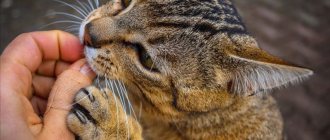- home
- Cats
- Not only “Kus”: Why do cats scratch when they are petted?
A cat is a unique creature with its own pattern of behavior and character manifestations. Sometimes it is impossible for a person to understand what a mysterious pet wants to tell him. A similar situation can be attributed to the moment when a cat shows affection or interest.
Evidence-based medicine refrains from answering the question posed: why does a cat scratch when it is petted? But experts who study zoopsychology in depth believe that the reasons for this behavior should be looked for at the origins of the domestication of wild cats. It is believed that cats behave this way because their predator instinct takes over. The same instinct does not allow some cats to stroke and touch themselves for a long time.
In the modern world, there are many artificially bred breeds, but do not forget that even the most harmless kitten can hide a hunter, and it is common for hunters to scratch and bite.
Why is a cat aggressive when you pet it?
Unlike dogs, cats have a low tolerance for petting and can get tired of it quickly. The time it takes for the strokes to go from pleasant to unpleasant depends on the cat. But when she reaches this point, the cat reacts almost as if she is in pain.
© shutterstock
Such aggression can be dangerous, especially for children. Learn to identify and avoid situations that may lead to this behavior.
Health problems must be ruled out
There are some medical conditions that can cause aggression in a cat, and you should rule them out before you try to change your pet's behavior.
Ask your veterinarian to check for signs of arthritis, injury, or dental problems to make sure it is not physical pain that is causing your cat to react aggressively when you pet her.
Reasons for biting and scratching
First, you need to decide on the terminology, and only then figure out what to do if the cat bites. Cats bite when petted in different ways:
- soft, gentle biting that does not cause harm or obvious discomfort, without the involvement of claws, is rare. This is usually how cats communicate with their kittens. If your hand becomes the object, it means you have been admitted into the holy of holies and accepted not just into a family, but deep into your heart;
- aggression on the part of the cat, when he tries to attack, scratch, becomes uncontrollable, makes you think about possible problems. Especially if this happens immediately after a normal and familiar life situation. But the cat was lying there, and you were petting him, and then suddenly the disposition changed and he turned into a real little devil: he began to bite and scratch.
Then it is really important to understand why the cat bites, so that the unpleasant situation does not repeat itself in the future.
It is clear that a cat bites and scratches if something does not suit it. But how can this happen when you stroke her? After all, this happens to mutual pleasure and even with obvious sound accompaniment in the form of contented purring. In fact, it's not that simple:
- If you have an aggressive cat, he may have problems with socialization. Ideally, kittens are actively raised and taught to receive hands and attention by their breeders. It is especially important to develop trust in a person before 7 weeks of age. If a cat has not received the basics of good manners, he does not always adequately perceive affection. Sometimes he attacks when you pet him.
- Instead of pleasure, the cat experiences pain. Pets cannot say that they have joint problems, stomach cramps, or skin injuries. If the situation repeats itself every time, and other reasons are excluded, then it makes sense to show your pet to a veterinarian, who will tell you why the cat bites.
- Static electricity discharge. This often happens when synthetic items are worn in close proximity or on you. It is hardly pleasant for a cat to receive an electric shock.
- Excessive attention. There are hypersocial cat breeds that urgently need to be close to their owner 24 hours a day, for example, Orientals. However, not everyone likes intrusive attention. There are more independent individualists who decide for themselves when they need communication and begin to bite and scratch when they are not happy with your attention.
- A cat may attack if it suddenly falls asleep while you are petting it. A careless movement, change of rhythm or force of pressure will, of course, wake her up. Frightened, the pet may well attack and even bite. Most often this happens to insufficiently socialized cats.
- Display of dominant behavior. Simply put, with its aggression, a cat or tom shows who is boss in the house. He tries to independently control the situation when he needs to be petted and when it is better not to touch him. Although, these are also costs of education. An intelligent animal must understand that it is forbidden to touch the owner, much less bite and scratch.
It’s much worse if a cat bites your legs or attacks you on the sly with obvious aggression. He doesn’t play, but tries to attack and cause injuries. Then the reasons for such behavior may lie much deeper and need to be resolved with specialists. In addition to veterinarians, there are cat psychologists who, after observing the animal and talking with the owner, will quickly determine solutions. The reasons often include hormonal imbalances, constant stress factors, resentment towards the owner’s behavior and an attempt to take revenge.
Signs of approaching aggression
A cat's body language can give us clues that your cat is about to bite you:
- A tense tail and flattened ears indicate an upcoming attack.
- Sudden dilation of a cat's pupil indicates excitement.
- An increased heart rate (which you can feel if the cat is on your lap) indicates that the cat is alert.
- A purr that turns to a growl—you need to back off.
Any one of these signs, or a combination of them, means that scratches or bites are imminent.
How to determine readiness for attack
Usually a cat does not bite your hand suddenly. He is preparing to attack, and this can be recognized by the following signs:
- first the cat stops “singing songs”;
- the purr begins to move its tail intensively;
- gradually the pet’s whole body becomes tense;
- he begins to growl, hiss, and “talk” with displeasure;
- pupils dilate;
- The ears either press down or actively move.
By observing your pet's behavior based on the above signs, you will be able to detect that the animal is showing dissatisfaction. Just remove your hand and the conflict will be over.
Subsequence
As long as your cat's bites and scratches stop your petting, the cat will continue to use it to control the interaction. You need to properly avoid situations that encourage your cat to bite. Manage the environment so your cat never has the opportunity to bite .
Be consistent. If you give up before you've established ground rules for affection and aggression, you'll have to start all over again.
Such bad cat habits often get worse before they disappear as your cat struggles to make the previous successful behavior work again.
Cruel but true
There is a procedure called “soft paws”, i.e. declawing. There is an important point - in cats, the claw is removed along with the first phalanx of the finger, which leads to severe pain in the postoperative period and abnormal gait in the future. Essentially, the cat learns to walk again. There is a study that says that declawed cats have increased aggression and increased incidences of biting.
In some countries, this procedure is strictly prohibited and the doctor may even be required to pay a fine. Even in Russia there are specialists who campaign against declawing cats.
Stroking threshold
Cats accept affection from other cats on their head and neck. But the stroking that a person does may seem unacceptable to them. It is this feeling of anxiety that stimulates the bites.
Limit your petting to the cat's head or the back of its neck. Then determine the stroke threshold. In other words, count the number of strokes your cat allows before becoming aggressive . Pay close attention to body language so you can stop before your cat bites you.
© shutterstock
This could be three strokes, five or more. Once you have determined this limit, stop so that you can control the situation. This is the key to changing behavior: letting your cat know that you are in charge of the situation.
If your cat is sitting on your lap when you reach petting threshold, do not push him away, otherwise he may cling to you in an attempt to attack your hands. To finish caressing, simply stand up without touching her.
If affection gives way to aggression
Often, cat owners are faced with a completely incomprehensible situation: a furry pet first purrs and caresses, and then suddenly suddenly changes its mood and begins to bite. Animal psychologists believe that the reason for this strange behavior is:
- Demonstration of independence . The fact is that predatory, hunting instincts are given to representatives of the cat family by nature itself. Therefore, an animal can exchange anger for mercy and, conversely, show that it is ready to give and receive affection only according to its mood and will not tolerate intrusiveness.
- Change of mood . Initially, stroking can really be pleasant for a furry pet, but after a while the cat gets tired of it, its mood changes, and with light bites it shows the owner that it is enough for now with displays of tenderness.
- The desire to keep the situation under control . Bites are a way to show that further events will develop depending on the pet’s wishes.
- Distrust of people – this pattern of behavior is often observed in animals picked up from the street, who have had to deal with human cruelty more than once. Therefore, the new member of the family will need a lot of time to adapt, and the owner will need patience.
In such situations, it is better to simply not bother the cat with your attention and try to correct its behavior in gentle but effective ways.
If bites occur periodically
Periodic bites indicate changes in the relationship between the owner and the pet and are not always something dangerous.
For example, during the game, a cat tries to “attack” the owner’s hand and can get very carried away. This means that the animal is in a very playful state and does not have very good control over its behavior. Trying to pet a pet while it is playing with a toy can also result in a clawed paw hitting the hand or a slight bite.
Train your pet to play with toys rather than with your hand
IMPORTANT: allow your pet to calm down after playing, then you can stroke and caress the cat.
Eliminate physical punishment when interacting with your pet: the animal will adopt an aggressive behavior pattern and try to protect itself. This is fraught not only with a bite, but also with a serious deterioration in relationships.
IMPORTANT: use a spray bottle to train your pet: small splashes of water will immediately let the animal know that it is doing the wrong thing.
Biting with pleasure
This is another common behavior. In this case, the cat purrs and bites when you pet him. That is, he responds to your affection in this way, and at the same time gives himself additional pleasure, just as we get it from chewing gum. In this case, it is necessary to correct his behavior from a very early age. Every attempt to bite you during the game must be blocked. The game stops, the owner shows dissatisfaction. If, when stroking is resumed, the cat no longer makes attempts to bite, then the stroking is performed as a reward.
Character traits
Why does a kitten bite: for no reason or when you pet it?
Regardless of the breed and its characteristics, any cat can be born harmful, and nothing can be done about it. It is impossible to correct your pet's character, but you can smooth it out a little. To do this, the cat must be given the opportunity to lose excess energy, buy her more toys, and play with her ourselves. A pet that has played enough will be much calmer and more patient with respect to touch.
Why does a cat bite
It is clear that an adult animal or kitten bites in situations when it feels uncomfortable and something does not bother them. For example, first the owner or mistress strokes the purr gently, softly, caresses behind the ears, and scratches the neck. The cat likes this manifestation of love, it relaxes and begins to purr.
After a while, the cat gets tired of such tenderness, the animal tenses, twists its ears to the sides, breathes nervously, and twitches its tail. Often, owners do not pay attention to this behavior, continuing to stroke the animal with even greater effort, which is why the pet simply attacks the person, trying to inflict a wound. This behavior is typical of an animal that feels threatened and in danger. In defense of themselves, cats bite the hands of the owner, after which they immediately hide, as they are afraid of imminent reprisals. The reasons for this behavior are different.
Aggressive breed
All cats are different, so some animals have a naturally peaceful disposition, while others are endowed with a violent character. Abyssinian, Bengal, jungle, savannah, and manul cats are considered the most vicious and biting. They are distinguished by their wild temperament, willfulness, vindictiveness and independence.
Scientists have found that the degree of aggressiveness of cats is related to color. Among animals of red, tricolor, black and gray-white colors, warlike individuals are most often found. Calmer animals are striped animals and cats with a monochromatic coat. Males naturally tend to be dominant and have a more violent temperament than females. Most often they show aggression during the period of sexual hunting.
We teach from childhood
Since it can be very difficult to wean a male cat from biting and scratching as an adult, you need to start training from a very early age. Toddlers often exhibit this behavior. It seems that this is normal, because he is learning to interact. But now we need to encourage only desirable behavior and cut off unnecessary behavior. Therefore, if during play the baby clasps your hand with its paws and begins to gnaw furiously, you need to loudly “shush” it and immediately stop the interaction. If the kitten demands to continue playing and clings to your finger again, then you can pat him by the collar, showing that this will not work.
Nonverbal Communication
This is another answer why a cat bites a petting hand. When you first touch your pet, he may like these caresses. However, at some point the monotonous movements begin to irritate. The animal cannot tell you “Enough”, “Don’t press so hard”, but its dissatisfaction begins to grow. Therefore, she uses the channels available to her. If the owner is unable to understand that the purr is experiencing discomfort, then the culmination will be a bite. The best solution would be to stop after a few minutes of petting. If the animal is determined for further contact, it will definitely demand continuation. Otherwise, he will calmly go about smoothing his fur coat.











